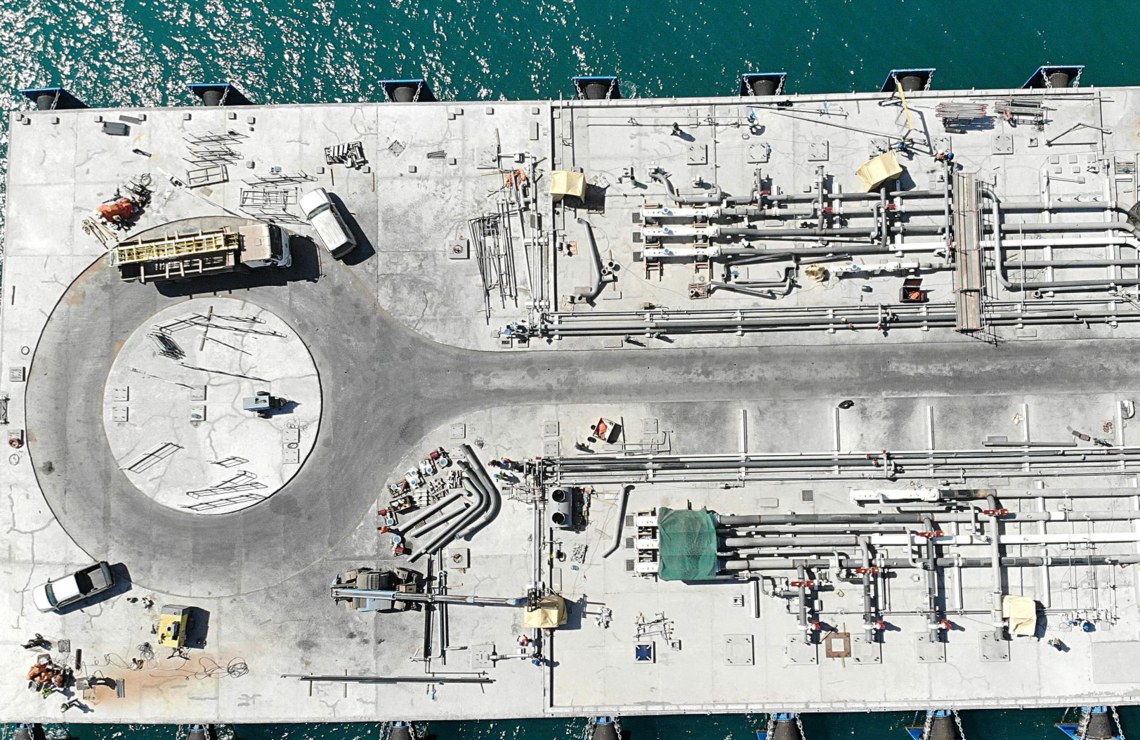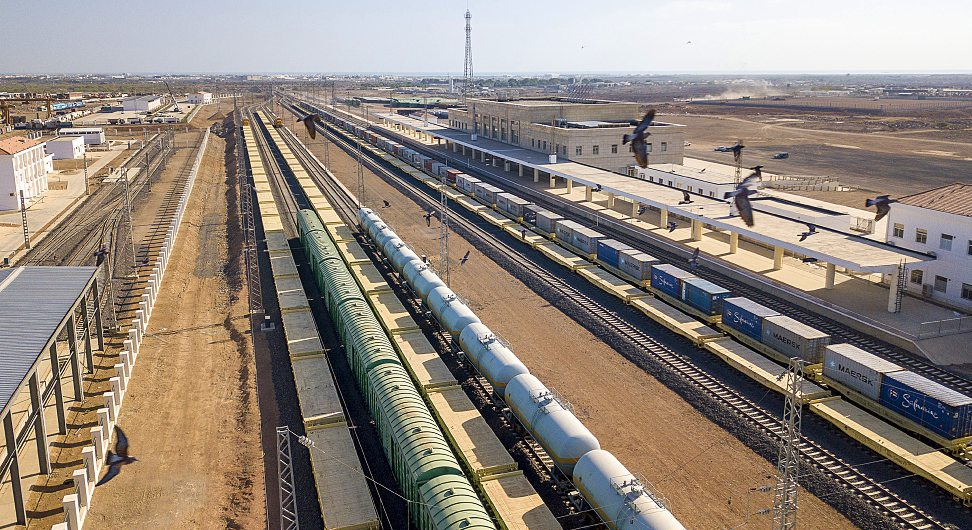
The damerjog project
Although primarily driven by Ethiopia's growing need for petroleum products, the new complex also has more global objectives: to meet massive regional demand, to step up onshore and offshore supply, and to position itself as a major player in storage and trading.
The first step has been taken! Three years after Moroccan company Somagec began construction work, the three-kilometre oil jetty at the new Damerjog petrochemical complex is now 95% complete.
In July last year, the Damerjog Free Trade Zone (Djibouti Damerjog Industrial Development Free Trade Zone) was granted a $155 million loan by Afreximbank and the Banque pour le Commerce et l'Industrie de la Mer Rouge (BCIMR, a subsidiary of BRED) to finish construction work. A terminal and an initial 150,000 m3 storage depot will complete the project.
Although the jetty is not yet fully operational, its delivery was one of the sine qua non conditions imposed by the private companies looking to set up and invest in the zone. Getting there took a tour de force by the Djibouti side, along with bridging finance from BCIMR.
It's temporary financing, typically intended to help a company meet its short-term costs until it can obtain long-term financing or raise equity capital. To avoid having to subsidise the financing of the infrastructure, to have visibility over the return on their investment and to be reimbursed, potential international financial backers in turn demanded a guarantee from these same private companies to finance the project. It was like a game of chicken and egg. But now that the jetty is built, Damerjog is becoming a reality!
Big ambitions
This land, which almost borders Somaliland, is the site of a 30 km2 free zone, of which 20 km2 will be reclaimed from the sea. The $4 billion project, the largest ever undertaken by the Djibouti Ports and Free Zones Authority (DPFZA), aims to rival the Fujairah mega-complex (United Arab Emirates), one of the largest oil storage centres in the Middle East, by 2035. While hydrocarbons already accounted for almost 30% of port traffic in Djibouti in 2020, the new terminal will eventually be able to handle 13 million tonnes of oil a year, compared with 4.5 million tonnes at current capacity. And it will have oil depots with a storage capacity of 750,000 m3.
Damerjog is thinking big. Ultimately, it will also include two wharves, a refinery, a cement plant (600,000 tonnes/year), a power station (2.3 MW), a ship repair yard with a metallurgical unit and, on paper, the landing point for a 765 km gas pipeline from the Ogaden region of Ethiopia. Though little progress has been made on the project since the agreement was signed with the Chinese company Poly-GCL, due to the instability in the region.
However, demand from the Ethiopian market is pressing. It's an enormous opportunity. Its landlocked neighbour has a population of over 123 million, and its hydrocarbon requirements are growing by more than 10% a year, equivalent to 15 million metric tonnes, according to the National Bank of Ethiopia's figures. The country's demand for petroleum products is expected to double over the next ten years.
For some time now, Abiy Ahmed's country has been putting pressure on its French-speaking neighbour to increase the storage capacity of its Horizon oil terminal, which was commissioned in 2005, and is operated and 52% owned by Emirates National Oil Company (ENOC), which is overheating in its efforts to keep up with demand, leaving many Ethiopian ships waiting for their turn offshore.
For Ethiopia, already short of foreign currency, the cost of being at a standstill at sea is significant, amounting to several million dollars each year. The Horizon extension project, planned for 2019, has so far come to nothing, because it was put on hold for technical reasons: it is bordered by the Chinese naval base, the port of Doraleh and the railway. There are also political reasons, as the terminal's shareholders include Abdourahman Boreh, the former head of the port authority. The exiled main opposition figure is accused of having received millions of dollars when the management of the port was awarded to DP World in 2000.
Investing in new business
Other than Ethiopia, Ismaïl Omar Guelleh's country intends to serve the entire East African ‘hinterland’, all the way to Kenya, where economic development and population growth necessitate the construction of roads, and therefore the transport of bitumen, another product derived from oil.
n April this year, South Sudan stated its intention to use Damerjog as a platform for exporting its oil to international markets, in a bid to break away from its dependence on Sudan, which is in the midst of a civil war. In 2022, Ethiopia, through its young sovereign wealth fund EIH, announced its intention to take a 30% stake in the liquid bulk port, in return for heavy investment. With the development of this industrial free zone specifically for hydrocarbons, Djibouti is establishing itself as a petrochemical hub for the region.
But that's not all. Djibouti also wants to position itself in the lucrative oil trading and tank storage business, where prices do not fluctuate with crude oil prices. Instead of relying on traders based in Dubai, Djibouti wants to serve its own customers in Africa and offshore. “It's a capacity business: the bigger the boats, the bigger the profits. Today, if you look at the bathymetric charts, you'd have to go as far as Durban or Port Elizabeth to find a draught as deep as Djibouti's, which is almost 16 metres deep,” explains Khalil Chiat, financial adviser to Aboubaker Omar Hadi, Chairman of DPFZA. With 35,000 ships and 3.4 million barrels of oil passing its shores every year, Djibouti has also launched a bunkering business with Red Sea Bunkering (RSB) for ships that used to be able to refuel in Jebel Ali (United Arab Emirates). To be more competitive, ships could also be refuelled ‘on shore’, rather than at sea as at present, says Khalil Chiat.
Non-threatening competition
Djibouti is also keen to maintain its lead. While this small republic on the Bab el-Mandeb strait supplies Ethiopia with 95% of its oil (the remaining 5% comes from Sudan), a rival is supplying weapons further south: Berbera, in Somaliland, whose recognition Ethiopia put back on the table last January, incurring Somalia's wrath.
Seen by Addis Ababa as an alternative to Djibouti until now its only outlet the Somaliland port, 51% owned by Ethiopia and operated by DP World, has attracted to its docks Swiss-based global trading giant Trafigura (turnover in excess of 300 billion dollars), which laid the foundation stone for its oil depot last August with an investment of 50 million dollars.
The Dubai-based port operator, which is persona non grata in Djibouti after being expelled from its quays by force of arms in 2018, has committed to investing $442 million in this Somaliland port, building a new container terminal in 2021 and a free zone in 2023.
In its memorandum of understanding with Somaliland, Ethiopia is seeking to negotiate the lease of a 20 km strip of coastal land, giving it direct access to the Red Sea. Djbouti officials see no cause for concern, praising the stability of their franc, their security, the depth of their harbours and their state-of-the-art infrastructure...
Ismaïl Omar Guelleh's country intends to serve the entire East African hinterland, all the way to Kenya
|
Djibouti and Ethiopia drive the train A symbol of the accomplishments of China's ‘New Silk Roads’, but also the heir to the ancient Franco-Ethiopian railway, the Djibouti-Addis Ababa line (752 km), launched in January 2017, is now managed by Ethiopia and Djibouti. On 10 May, the two countries, which own 75% and 25% respectively, took over the management and maintenance of the network from the Chinese companies CCECC and CRCC, following a ceremony held in Addis Ababa. Between July 2023 and April 2024, the route generated a turnover of $50 million (+$1.12 million) and saw a 15% increase in traffic, with 148,664 passengers. By 2023, it had carried 2.1 million tonnes of freight, compared with 885,000 tonnes the year it was launched. With a total construction cost of $3.4 billion, the railway initially encountered a number of problems relating to the cost of electricity, power cuts, collisions with animals and a volume of goods that fell short of expectations. It encounters stiff competition from Ethiopian trucks, which makes it no more competitive. It also contributed heavily to Djibouti's debt to China. R.D. 
|